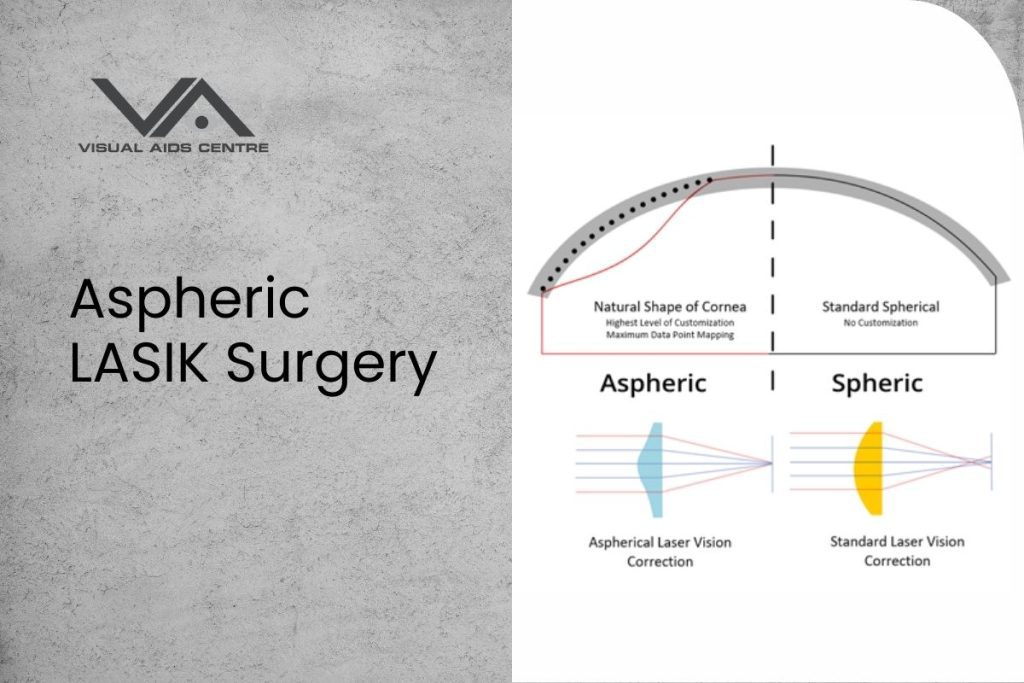Table of Contents
Toggle
Advanced laser eye surgery techniques have changed the game in ophthalmology. They give patients a chance to see clearly without glasses or contact lenses.
This new method keeps the cornea’s natural shape. It helps you see sharper and reduces glare and halos at night.
It’s great for those who want to fix their vision without losing quality. This is key for many people.
By changing the cornea’s shape, this surgery boosts your vision. It also cuts down on side effects from older laser surgeries.
What is Aspheric LASIK Surgery?
Aspheric LASIK is a new way to fix vision problems. It keeps the natural shape of the cornea. This method is great for people with big pupils or those who see poorly at night.
This surgery is made just for you. It uses special technology to correct your vision better than old LASIK methods. It’s all about making your vision sharp and clear.
Aspheric LASIK reduces eye problems that can happen with regular LASIK. You’ll see better in the dark and have clearer vision overall. This is because it corrects your vision more precisely.
It’s all about you. Your surgery is planned just for your eyes. This means you get the best vision correction possible. It’s all about making your vision sharp and clear.
Benefits of Aspheric LASIK
Aspheric LASIK uses advanced technology. It gives patients sharper vision and fewer complications than traditional LASIK.
This method reduces aberrations, leading to better visual quality. It’s a premium LASIK surgery. It offers improved night vision and less glare, making it great for those seeking advanced LASIK treatment.
Enhanced Visual Acuity
Aspheric LASIK creates a more natural cornea shape. This improves visual acuity, making life better for patients.
Faster Recovery Times
Aspheric LASIK also has a quicker recovery. Patients can get back to their daily routines in just a few days. It’s perfect for those with busy lives.
In summary, Aspheric LASIK is a big leap forward in laser eye surgery. It offers many benefits, making it a top choice for vision correction.
Who is a Good Candidate for Aspheric LASIK?
To be a good candidate for Aspheric LASIK, several factors are important. People must meet certain criteria to be eligible for this advanced laser eye surgery.
First, candidates must be at least 18 years old. They also need to have stable vision for at least a year before surgery. This makes sure their prescription isn’t changing, helping predict the surgery’s outcome.
It’s also important to not have certain eye diseases. Conditions like cataracts, glaucoma, or keratoconus might not be suitable for Aspheric LASIK. A pre-surgery check-up with a Top Aspheric LASIK Surgeon is key to see if you’re a good fit.
Pre-Surgery Consultation: A Critical Step
At the consultation, the Best Aspheric LASIK Surgeon will do a detailed eye check. They’ll look at the cornea’s thickness, pupil size, and eye health.
This meeting is also a chance to talk about what you hope to achieve. You’ll learn about the possible results of Aspheric Lasik Surgery.
Common Eye Conditions Treated with Aspheric LASIK
Aspheric LASIK is often used for myopia (nearsightedness), hyperopia (farsightedness), and astigmatism. It can greatly improve your vision, possibly making glasses or contacts unnecessary.
Talking to a qualified surgeon can help decide if Aspheric LASIK is right for you. A detailed check-up by a Top Aspheric LASIK Surgeon or Best Aspheric LASIK Surgeon will help figure out if it’s a good choice.
The Aspheric LASIK Procedure Explained
The Aspheric LASIK procedure is a detailed process to fix vision issues. It starts with a thorough check to see if the patient is right for the surgery.
First, advanced tools map the cornea and check the eyes’ health. This info helps make a treatment plan just for the patient.
Pre-Operative Assessment
The first step is a series of tests. These tests check the cornea’s thickness, shape, and refractive error. They help figure out the exact changes needed for clear vision.
After the tests, if the patient is a good fit for Aspheric LASIK, the surgery starts. A femtosecond laser makes a thin flap in the cornea. Then, the flap is gently lifted to expose the tissue underneath.
Surgical Process
An excimer laser, guided by Aspheric Wavefront Technology, reshapes the cornea. This tech makes sure the correction fits the patient’s eyes perfectly, ensuring a precise and effective fix.
The laser treatment is quick, lasting just a few seconds. The whole surgery, from start to finish, takes about 30 minutes per eye.
Post-Operative Care
After surgery, caring for the eyes is key for a smooth recovery. Patients get eye drops to keep the eyes moist and prevent infection.
Follow-up visits are also important. They help track the healing and address any issues. Following the care instructions helps avoid complications and ensures the best results.
Aspheric LASIK is a big step forward in Customized LASIK Surgery. It offers a personalized and effective way to correct vision. Knowing how the procedure works helps patients make better choices about their treatment.
Potential Risks and Side Effects
Aspheric LASIK is a cutting-edge treatment, but it’s important to know its risks and side effects. Like any surgery, it comes with possible complications.
Common side effects include dry eyes, glare, and halos. These usually go away within a few weeks or months. Dry eyes can be helped with eye drops, and glare and halos may lessen as the eye heals.
Long-term risks are rare but can include vision problems, infection, and dry eye syndrome. But, new LASIK technologies have made these risks much lower.
To lessen risks and side effects, follow your doctor’s post-op care advice. Use eye drops as directed, go to follow-up visits, and avoid hard activities early on. This helps avoid complications and ensures a smooth healing process.
Knowing the risks and side effects of Aspheric LASIK is key for those thinking about it. Being informed and taking steps to reduce risks helps make the best choice for your eyes. This way, you can enjoy the benefits of Aspheric LASIK safely.
What to Expect During Recovery
Knowing what to expect during recovery is key for those who have chosen Aspheric LASIK Surgery. The healing process starts quickly, with most seeing big improvements in a few days.
It’s important to have follow-up visits with your surgeon. These visits help your surgeon check on your healing, answer any questions, and guide you on care. You’ll likely have visits in the first few days, then more over weeks and months.
There are some lifestyle changes to make during recovery. You should avoid rubbing your eyes, use eye drops as directed, and keep your eyes away from dust. Also, rest well and avoid hard activities to help your eyes heal smoothly.
Post-Operative Care
Following your surgeon’s post-operative instructions is critical for a good outcome. By knowing what to expect and following these guidelines, you can make your recovery better. This way, you can fully enjoy the results of your Customized LASIK Surgery.
Innovations in Aspheric LASIK Technology
New advancements in Aspheric LASIK technology have made laser eye surgery more precise and tailored. Today’s advanced laser systems allow surgeons to customize treatments for each patient’s eyes. This means better results for everyone.
Aspheric Wavefront Technology is a big leap in Aspheric LASIK. It maps the eye’s surface in detail. This leads to treatments that are both precise and effective in fixing vision problems.
Advanced Laser Systems
The newest laser systems in Aspheric LASIK surgery are packed with advanced features. These features improve the procedure’s accuracy and safety. They also make treatments faster, leading to better vision for patients.
Personalized Treatment Plans
Modern Aspheric LASIK technology focuses on personalization. Surgeons create treatment plans that fit each patient’s unique eye characteristics. This approach has greatly boosted patient satisfaction.
The growth of Aspheric LASIK technology is a major advancement in eye surgery. With its advanced lasers and custom plans, Aspheric LASIK is a top choice for vision correction. It stands as a model of Premium LASIK Surgery.
Making an Informed Decision
When thinking about Aspheric LASIK Surgery, it’s key to get advice from skilled eye care experts. You should also do your homework on the good and bad sides of Premium LASIK Surgery.
Knowing how Advanced LASIK Treatment works, including its benefits, helps you get ready for the surgery and healing. This makes the switch to better vision smoother.
Before the surgery, ask your doctor important questions. Find out about possible risks, side effects, the technology used, and what results you can expect. This ensures you’re ready for the surgery and healing.
By doing these things, you can make a smart choice about your eye care. This is the first step to enjoying the perks of Aspheric LASIK.













